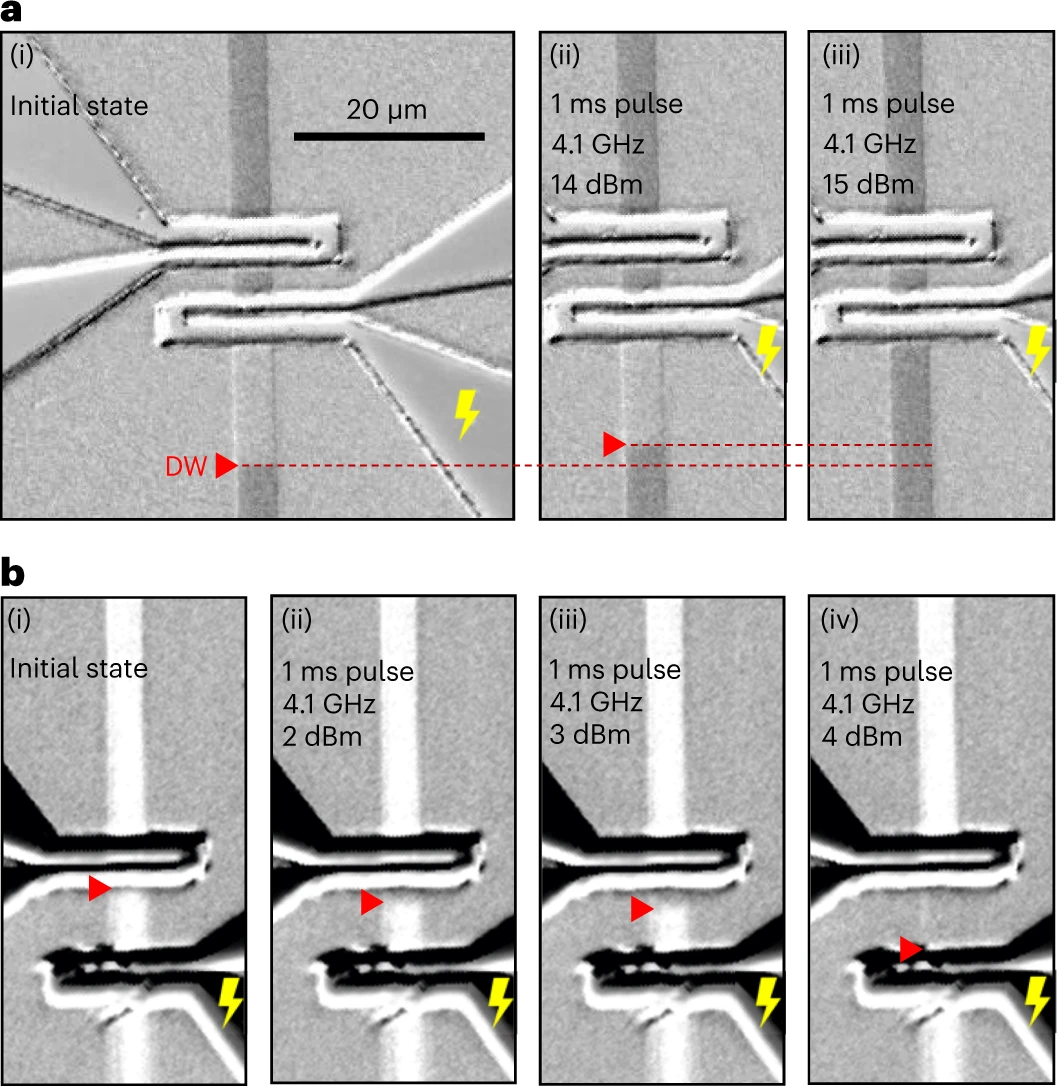Magnons, or spin waves, are magnetic excitations that can carry spin information.1 Spin waves in low-damping magnetic materials are the foundation for building magnonic devices, magnetic counterparts to traditional CMOS microelectronics.2,3
Magnons interact with magnetic textures such as domain walls, leading to domain wall motion or attenuation of the spin waves.4-6 These phenomena provide methods of writing and reading magnetic bits for magnonic devices. Han et al. demonstrated mutual interactions between magnons and domain walls in metallic Co/Ni multilayer films.7 However, large damping in the metallic film limits domain wall velocities, implying slow reading and writing speeds and high power requirements for magnonic devices.
Bismuth-doped yttrium iron garnet (BiYIG) is an insulating ferrimagnet with one of the lowest reported damping coefficients. Its low-damping and insulating properties allow magnetic domain walls to propagate through BiYIG with high velocities and minimal energy loss,8,9 and unlike YIG, it can be grown as a thin film with out-of-plane magnetization, enabling a high density of magnetic domains to be stabilized. Thus, this material serves as a leading candidate for magnonic device applications.
In our study, we demonstrate interactions between magnons and domain walls in BiYIG, generating the magnons by applying a GHz signal to an overlaid antenna and observing the domain walls using magnetooptical Kerr effect microscopy (see figure below). A key result is the motion of domain walls over distances of 15 µm using a 1 ns pulse. The low damping in BiYIG means spin wave-driven domain wall motion requires orders of magnitude less energy than that reported in metallic systems. These results facilitate the development of energy efficient magnonic devices utilizing spin wave/domain wall interactions to read and store information.

Magnon-induced DW motion. The injector antenna and DW are indicated with a yellow lightning bolt and red arrow, respectively. a, MOKE images of a DW in the initial state (i), after the first pulse at 14 dBm (ii) and the second pulse at 15 dBm (iii) applied at the lower antenna, using a 1 ms pulse at 4.1 GHz. In (iii), the DW moving towards the lower antenna probably annihilated with a DW pinned under that antenna. b, A DW formed near the upper antenna edge in the initial state (i) and after a 1 ms pulse at 2 dBm (ii), 3 dBm (iii) and 4 dBm (iv) applied at the lower antenna at 4.1 GHz.
To learn more, please check out our publication “Coherent magnon-induced domain wall motion in a magnetic insulator channel” in Nature Nanotechnology: https://www.nature.com/articles/s41565-023-01406-2
References
1 Kajiwara, Y. et al. Transmission of electrical signals by spin-wave interconversion in a magnetic insulator. Nature 464, 262-266, doi:https://doi.org/10.1038/nature08876 (2010).
2 Chumak, A. V., Vasyuchka, V. I., Serga, A. A. & Hillebrands, B. Magnon spintronics. Nature Physics 11, 453, doi:10.1038/nphys3347 (2015).
3 Sheng, L., Chen, J., Wang, H. & Yu, H. Magnonics Based on Thin-Film Iron Garnets. Journal of the Physical Society of Japan 90, 081005, doi:10.7566/JPSJ.90.081005 (2021).
4 Yan, P., Wang, X. S. & Wang, X. R. All-Magnonic Spin-Transfer Torque and Domain Wall Propagation. Physical Review Letters 107, 177207, doi:10.1103/PhysRevLett.107.177207 (2011).
5 Pirro, P. et al. Experimental observation of the interaction of propagating spin waves with Néel domain walls in a Landau domain structure. Appl. Phys. Lett. 106, 232405, doi:10.1063/1.4922396 (2015).
6 Sheng, L. et al. Spin wave propagation in a ferrimagnetic thin film with perpendicular magnetic anisotropy. Applied Physics Letters 117, 232407, doi:10.1063/5.0024424 (2020).
7 Han, J., Zhang, P., Hou, J. T., Siddiqui, S. A. & Liu, L. Mutual control of coherent spin waves and magnetic domain walls in a magnonic device. Science 366, 1121-1125, doi:10.1126/science.aau2610 %J Science (2019).
8 Fakhrul, T. et al. Magneto-Optical Bi:YIG Films with High Figure of Merit for Nonreciprocal Photonics. Advanced Optical Materials 7, 1900056, doi:https://doi.org/10.1002/adom.201900056 (2019).
9 Kumar, R., Samantaray, B. & Hossain, Z. Ferromagnetic resonance studies of strain tuned Bi:YIG films. Journal of Physics: Condensed Matter 31, 435802, doi:10.1088/1361-648x/ab2e93 (2019).









Please sign in or register for FREE
If you are a registered user on Research Communities by Springer Nature, please sign in